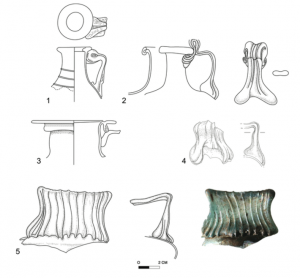
Free-blown jugs from (1) ʿAraq en-Naʿsaneh (Wadi ed-Daliyeh); (2) Cave of Horror; (3) Cave of the Sandal (Cave VIII/28); and (4, 5) ʿAbud Cave. (Drawings by Y. Rudman; photo by P. Shrago; drawings digitally formatted by S. Pirsky; courtesy of the American Schools of Oriental Research, the Israel Exploration Society, the Israel Antiquities Authority, and R. Porat)
BASOR No. 376, November article, “Glass Vessel Use in Time of Conflict: The Evidence from the Bar Kokhba Refuge Caves in Judaea, Israel (135/136 C.E.),” by Ruth Eve Jackson-Tal (Institute of Archaeology, The Hebrew University of Jerusalem).
This article concentrates on the overall analysis of the glass vessel finds, some published here for the first time, recovered in numerous excavations and surveys in refuge caves, in Judaea, Israel. These caves were used by Jewish refugees fleeing the Roman army in the late stages of the Bar Kokhba revolt in 135/136 C.E. The glass vessels consist mostly of daily bowls, beakers, jars, bottles, and jugs. However, a few luxury vessels, such as the renowned molded and wheel-cut bowls from the Cave of Letters, were also found. Therefore, the comprehensive study of the glass finds discovered in refuge caves, used in a time of a major political conflict, offers a rare possibility to promote our understanding of social, cultural, chronological, and regional issues through the study of glass vessel use by a specific ethnic group in a very narrow date frame.